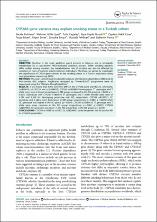| dc.contributor.author | Pehlivan, Sacide | |
| dc.contributor.author | Uysal, Mehmet Atilla | |
| dc.contributor.author | Çağatay, Tülin | |
| dc.contributor.author | Nursal, Ayşe Feyda | |
| dc.contributor.author | Kekik Çınar, Çiğdem | |
| dc.contributor.author | Erkan, Feyza | |
| dc.contributor.author | Sever, Ülgen | |
| dc.contributor.author | Bingöl, Züleyha | |
| dc.contributor.author | Pehlivan, Mustafa | |
| dc.contributor.author | Pençe, Sadrettin | |
| dc.date.accessioned | 2019-05-13T09:08:00Z | |
| dc.date.available | 2019-05-13T09:08:00Z | |
| dc.date.issued | 2018 | |
| dc.identifier.citation | Pehlivan, S., Uysal, M. A., Cağatay, T., Nursal, A. F., Kekik Çınar, Ç., Erkan, F., Sever, Ü., Bingöl, Z. [et. al.]. (2018). CYP2A6 gene variants may explain smoking status in a Turkish cohort. Psychiatry and Clinical Psychopharmacology. | en_US |
| dc.identifier.issn | 2475-0573 | |
| dc.identifier.uri | https://doi.org/10.1080/24750573.2018.1547177 | |
| dc.identifier.uri | https://hdl.handle.net/11491/1917 | |
| dc.description.abstract | OBJECTIVE: Nicotine is the main addictive agent present in tobacco and is principally metabolized by a cytochrome P450-mediated oxidation process. While smoking patterns differ widely among smokers, the metabolization rate of nicotine can also be affected by variations in rates of enzyme activity between individuals. Therefore, we aimed to investigate the significance of CYP2A gene variants in the smoking status in a Turkish population using next-generation sequencing (NGS). METHODS: This case–control study involved 64 subjects with Nicotine dependence (ND) and 36 Non-smoker (NS) subjects. Amplicants designed by “Primer-BLAST” programme were all sequenced using the “Illimuna-MiseqQ-platform”. RESULTS: It was found that there were five SNPs in the CYP2A6 gene (rs8192725, rs7248240, rs1809810, rs8192733 and rs28399435). CYP2A6 rs1809810 homozygous TT genotype and T allele were seen in lower percentages in ND group compared to the NS group (p =0.045; p =0.021). Individuals with CYP2A6 rs1809810 TT genotypes and T allele showed odds ratio of 4.760 and 5.360 for developing protective role ND, respectively. CYP2A6 rs8192733 CC genotype and C allele were both lower in ND group (respectively p =0.001, p =0.023) while GC genotype was higher in the ND group (p =0.004). CYP2A6 rs28399435 TT genotype and T allele were more common in the ND group (respectively p =0.001, p =0.001). CYP2A6 rs28399435 CC genotype was lower in the ND group than in the NS group (p =0.010). CONCLUSIONS:CYP2A6 rs1809810, rs8192733, rs28399435 could be genetic risk factors for ND in a Turkish population. © 2018, © 2018 The Author(s). Published by Informa UK Limited, trading as Taylor & Francis Group. | en_US |
| dc.language.iso | eng | |
| dc.publisher | Taylor and Francis Ltd. | en_US |
| dc.relation.isversionof | 10.1080/24750573.2018.1547177 | en_US |
| dc.rights | info:eu-repo/semantics/openAccess | en_US |
| dc.subject | CYP2A6 | en_US |
| dc.subject | Next Generation Sequencing | en_US |
| dc.subject | Smoking | en_US |
| dc.subject | Variant | en_US |
| dc.title | CYP2A6 gene variants may explain smoking status in a Turkish cohort | en_US |
| dc.type | article | en_US |
| dc.relation.journal | Psychiatry and Clinical Psychopharmacology | en_US |
| dc.department | Hitit Üniversitesi, Tıp Fakültesi, Dahili Tıp Bilimleri Bölümü | en_US |
| dc.authorid | 0000-0001-7639-1122 | en_US |
| dc.relation.publicationcategory | Makale - Uluslararası Hakemli Dergi - Kurum Öğretim Elemanı | en_US |
| dc.authorscopusid | 6701592936 | |
| dc.authorscopusid | 14826142700 | |
| dc.authorscopusid | 19641891800 | |
| dc.authorscopusid | 55820023600 | |
| dc.authorscopusid | 6504219013 | |
| dc.authorscopusid | 6701687493 | |
| dc.authorscopusid | 57195570574 | |
| dc.description.scopuspublicationid | 2-s2.0-85057596434 | en_US |


















